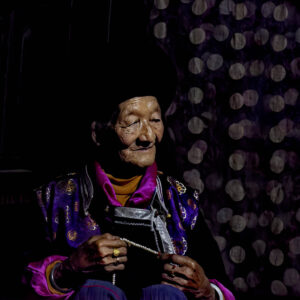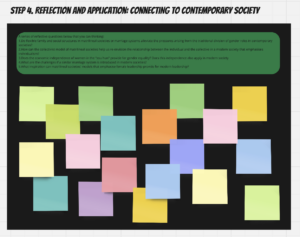Becoming an Elephant: Into a Matriarchal Society

Summary
An initial exploration of the distinctive values of matrilineal societies and matrimonial systems, revealing how they provide inspiration and reflection on issues of gender, family and community in contemporary society through co-operation, equality and sustainability.
Start! Follow these steps
Note: This toolkit is designed to encourage collaboration among multiple participants. However, if you are working alone, don’t worry—you can still complete all the other steps except for the third step. Skipping the third step will not affect the overall learning content or outcomes.
Step 1. Introduction to Matriarchal Society (2 minutes)
A quick overview of matriarchal society, explaining how it differs from the patriarchal system and introducing key concepts such as matriarchal society, community decision-making and gender roles. (a short written introduction containing key terms and definitions.)

Mosuo women, Yongning” by jiulong ,2018
A matriarchal society is a social structure centered around women, where property and lineage are passed down through the maternal line. Unlike patrilineal societies, women in matriarchal systems hold significant decision-making power, and children typically live with their mothers, while fathers play a relatively minor role. Relationships within the family are primarily based on maternal kinship, with siblings collectively raising the next generation. This societal structure emphasizes the important role of women in family and community life, creating a unique social bond (Xu, 2014).
The Mosuo people, an ethnic minority in China, are one of the most prominent examples of a matriarchal society. They are mainly located around Lugu Lake, which lies at the border of Yunnan and Sichuan provinces. In Mosuo families, elder women take on the primary leadership roles, and descendants belong to the mother’s lineage. The Mosuo have a rich cultural heritage, including a blend of Dongba religion and Tibetan Buddhism, their own language, and vibrant traditional festivals. In this familial structure, men often assist in raising their sisters’ children, while women serve as the central figures in the household (Xu, 2014).
Walking marriage, or “zou hun” is the most distinctive marital practice of the Mosuo people. This unique system is not based on a conventional spousal relationship; instead, men and women continue to live in their respective maternal households. Men visit their partners at night in a custom known as “night visits,” returning to their own families by morning. (Duan, 2016)The essence of walking marriage lies in its freedom and flexibility, allowing men and women to choose and maintain romantic relationships without formal legal or social obligations. Children are raised by the mother and her extended family, with fathers providing emotional support rather than day-to-day care (Xu, 2014).
Step 2. Documentary film on the Mosuo community in China (6 minutes)
Chow Han Shan , Tisese: A Documentary on Three Mosuo Women (2001)
Step 3. Role-play simulation: community decision-making (8 minutes)
👆Don’t worry if you are a solo learner, you can click on this image and discuss it with other learners on the thread.
Scenario One: Marriage and Family Legacy – New Choices in the Walking Marriage System
Background
In our community, the walking marriage system is a traditional way of getting married. But, modernization has made some people start to question this tradition. You need to come up with some new ideas about the walking marriage system and family legacy for the family meeting.
Role Choices
A. Traditional Guardian: Supports the significance of the walking marriage system, viewing it as a fundamental aspect of community culture.
B. Modern Advocate: Advocates for the inclusion of contemporary marriage practices.
C. Neutral Mediator: Seeks to find a middle ground between traditional values and modern influences, while maintaining community cohesion.
Decision-Making Steps (Perspectives and Positions Available)
- On the Future of the Walking Marriage System:
Keep the existing walking marriage system in place.
It’s important to have different choices when it comes to marriage, so that everyone can pick the type of marriage that suits them best.
We should consider reforming the walking marriage system by establishing a clearer distribution of family responsibilities.
- On Family Legacy:
Continue following matrilineal inheritance, with women inheriting property and land.
It might be a good idea to provide some resources for younger men so that more family members can get involved in community development.
Set aside a portion of the land to be managed as shared property by the community.
- On Family Meeting Conflicts:
Persuade traditionalists to accept moderate reforms to meet the needs of younger generations.
Appeal to modernists to understand the cultural significance of tradition.
Step 4. Reflection and Application: Connecting to Contemporary Society (4 minutes)
- Do flexible family and social structures in matriarchal societies or marriage systems alleviate the pressures arising from the traditional division of gender roles in contemporary societies?
- How can the collectivist model of matriarchal societies help us re-envision the relationship between the individual and the collective in a modern society that emphasises individualism?
- Does the economic independence of women in the “zou hun” provide for gender equality? Does this independence also apply in modern society
- What are the challenges if a similar marriage system is introduced in modern societies?
- What inspiration can matrilineal societies’ models that emphasise female leadership provide for modern leadership?
三个摩梭女人的故事 A Documentary on Three Mosuo Women © 2001 by CHAU WAH SHAN is licensed under CC BY-SA 4.0.
“Mosuo women, Yongning” © 2018 by jiulong is licensed under CC BY-SA 4.0.
“Organization-group” © 2018 by Ranjithsiji is licensed under CC BY-SA 4.0.
Xu, Q. (2014). 从摩梭人生活现状谈摩梭走婚|文章|中国国家地理网. [online] www.dili360.com. Available at: http://www.dili360.com/article/p5417fd7cd2a1701.htm.[Accessed 30 Nov. 2024]
Duan, Y. (2016). 摩梭人的走婚制:人类婚姻制度的未来?_私家历史_澎湃新闻-The Paper. [online] Thepaper.cn. Available at: https://www.thepaper.cn/newsDetail_forward_1503772 [Accessed 30 Nov. 2024].




